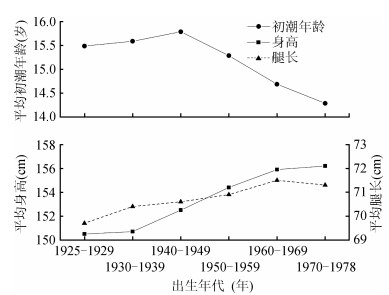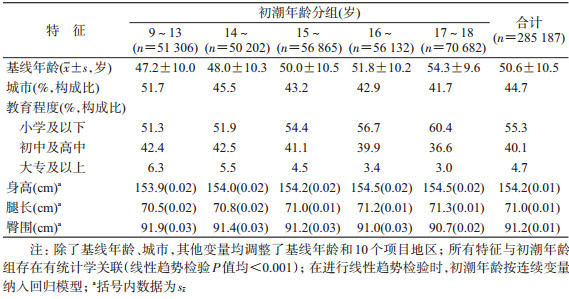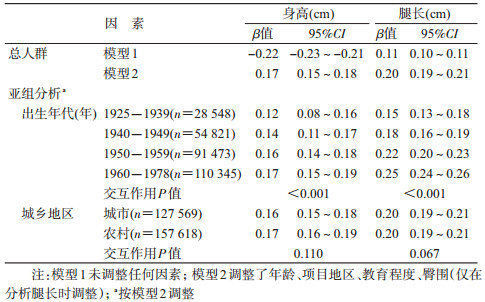文章信息
- 林丽玲, 郑棒, 吕筠, 郭彧, 卞铮, 余灿清, 杨玲, 周汇燕, 谭云龙, 裴培, 陈君石, 陈铮鸣, 李立明 .
- Lin Liling, Zheng Bang, Lyu Jun, Guo Yu, Bian Zheng, Yu Canqing, Yang Ling, Zhou Huiyan, Tan Yunlong, Pei Pei, Chen Junshi, Chen Zhengming, Li Liming .
- 中国10个地区成年女性初潮年龄与身高和腿长的关联研究
- Association between age at menarche and height and leg length in adult women: findings from survey in 10 areas in China
- 中华流行病学杂志, 2016, 37(11): 1454-1458
- Chinese journal of Epidemiology, 2016, 37(11): 1454-1458
- http://dx.doi.org/10.3760/cma.j.issn.0254-6450.2016.11.004
-
文章历史
收稿日期: 2016-05-29
2. 100730 北京, 中国医学科学院;
3. 100022 北京, 国家食品安全风险评估中心;
4. 英国牛津大学临床试验与流行病学研究中心
2. Chinese Academy of Medical Sciences, Beijing 100730, China;
3. China National Center for Food Safety Risk Assessment, Beijing 100022, China;
4. Clinical Trial Service Unit and Epidemiological Studies Unit(CTSU), Nuffield Department of Population Health, University of Oxford, UK
初潮年龄、身高和腿长均可一定程度反映个体在儿童青少年时期的环境和营养状况,常被作为某些因素的代理指标,分析与成年期疾病结局的关联[1-2]。一些发达国家的数据显示,女性的平均月经初潮年龄从19世纪中期的17岁提前到20世纪中期的13岁[3-4]。1960年后,不同国家女性的初潮年龄变化趋势不尽相同:一些发达国家女性的初潮年龄趋于稳定或呈现略微推迟趋势[5-6];而中国[7-8]、墨西哥[9]、南非[10]等发展中国家女性的初潮年龄仍呈现逐渐提前的趋势。与此同时,大多数国家和地区人群的身高均有逐渐增加的趋势[5, 11]。初潮年龄与身高或腿长关联的研究发现,女性初潮年龄越晚,身高或腿长值越高[12-15]。本研究利用中国慢性病前瞻性研究(China Kadoorie Biobank,CKB)项目的基线调查数据,描述项目覆盖的10个地区30~79岁成年女性初潮年龄和身高的地区和出生年代分布,并分析初潮年龄与身高和腿长的关联。
对象与方法1.研究对象:CKB项目于2004-2008年在城乡各5个项目地区招募调查对象并完成基线调查,其具体信息见参考文献[16-18]。本文以城市名称表示城市项目点,以省份名称表示农村项目点。研究对象中有完整基线调查数据的女性共302 632人,剔除初潮年龄信息缺失者44人及正常生理初潮年龄以外(<9岁或>18岁)[17]者17 401人,最终纳入分析285 187人。
2.研究方法:通过调查员面对面询问获得一般人口社会学信息(年龄、项目地区、教育程度)和初潮年龄。由培训合格的调查员采用统一工具按常规方法测量获得身高、坐高和臀围等体格指标数据。腿长值通过身高减去坐高(从臀部到头颅顶部的躯干长度)获得。测量臀围时,检查者在找出了被检查者臀部的最大伸展度后,将皮尺环绕臀部一周后读数。身高、坐高和臀围均精确到0.1 cm。CKB项目在基线调查结束后分别于2008年和2014年各抽取约5%的研究对象进行了重复调查。两次重复调查各包括12 018和15 427名女性,研究对象均又自报了初潮年龄。比较分析相同个体重复自报的初潮年龄,基线调查与第一次和第二次重复调查结果的组内相关系数(intra-class correlation coefficients,ICC)分别为0.84(95%CI:0.83~0.84)和0.79(95%CI:0.76~0.82),提示自报初潮年龄具有较好的信度。
3.统计学分析:描述研究人群的初潮年龄、身高和腿长的地区(10个项目地区)和出生年代(每10年一组)分布,比较分析不同初潮年龄者(9~13、14、15、16、17~18岁)相关特征的差异。应用多元线性回归模型分别分析初潮年龄(连续变量)与身高或腿长的关系,同时调整年龄(岁,连续变量)、10个项目地区和教育程度(未正规上过小学、小学、初中、高中、大专及以上)。在分析初潮年龄与腿长关系时,额外调整臀围[19](cm,连续变量)。进一步分析初潮年龄与身高或腿长的关联在不同出生年代(1925-1939年、1940-1949年、1950-1959年、1960-1978年)或城乡人群间是否一致,根据特征变量与初潮年龄的乘积交互项系数的t检验结果,判断是否存在交互作用。数据分析使用Stata 13.1软件。所有检验为双侧检验,P<0.05为差异有统计学意义。
结果本研究共纳入分析285 187名女性,平均年龄(50.6±10.5)岁。平均初潮年龄(15.2±1.7)岁,城市人群(15.1岁±1.7岁)早于农村(15.3岁±1.7岁),P<0.001;平均身高(154.2±6.0)cm,城市人群(155.4 cm±5.9 cm)高于农村(153.3 cm±5.9 cm),P<0.001;腿长均值为(71.0±3.7)cm,城市人群(71.2 cm±3.7 cm)高于农村(70.8 cm±3.7 cm),P<0.001。10个项目地区平均初潮年龄为14.6~15.4岁,其中平均初潮年龄最早的地区是柳州(14.6岁)(多重检验校正P<0.05)。图 1为不同项目地区平均身高和腿长值,分别为150.0~158.3 cm和69.2~72.9 cm,其中以青岛地区女性的身高和腿长值均最高,分别为158.3 cm和72.9 cm;四川地区女性的身高和腿长值最低,分别为150.0 cm和69.2 cm(多重检验校正均P<0.05)。女性身高和腿长值均呈现随出生年代逐渐增加的趋势(线性趋势检验P<0.001)。1940-1949年出生的个体其初潮年龄略有推迟,其后出生的女性则表现为初潮年龄逐渐提前的趋势(线性趋势检验P<0.001),见图 2。

|
| 注:U为城市项目点,R为农村项目点;右图白色矩形为腿长,全长为身高 图 1 我国10个项目地区女性的平均初潮年龄及身高和腿长 |

|
| 图 2 我国10个项目地区不同出生年代女性的平均初潮年龄及身高和腿长 |
与初潮年龄较晚者相比,初潮年龄较早者表现为其平均年龄更小,城市女性更多,教育程度更高,身高和腿长值更小,臀围值更大(线性趋势检验均P<0.001)。见表 1。
表 2为初潮年龄与身高和腿长关联的多因素分析及亚组分析结果。可见,在调整了年龄、地区、教育程度和臀围(仅在分析腿长时调整)后,初潮年龄每推迟1岁,身高和腿长分别平均增加0.17 cm和0.20 cm(均P<0.001)。初潮年龄与身高和腿长的关联在城乡地区的差异无统计学意义(交互检验,均P>0.05)。相比出生年代较早者,出生年代越晚,其初潮年龄与身高和腿长的回归系数越大(交互检验,均P<0.001)。
本研究发现,初潮年龄随着时代的迁移呈现逐渐提前的趋势,身高和腿长则呈现逐渐增加的趋势;在调整可能的混杂因素后,初潮年龄越晚的个体其身高和腿长值越大;出生年代越晚者,身高和腿长值随初潮年龄后移而增加的幅度越大。
本研究人群的平均初潮年龄为15.2岁,接近于以往研究报告的我国其他地区女性平均水平[2, 13]。相比之下,欧美国家女性的平均初潮年龄要更早,大多在12~14岁[6, 14-15, 20]。如美国全国健康与营养调查(NHANES)中出生于1920-1970年的女性平均初潮年龄为12.5~13.2岁[20];欧洲癌症与营养前瞻性研究(EPIC)中出生于1918-1964年的女性人群为12.5岁[15]。与大多数欧美或亚洲国家女性一样,本研究人群也表现出月经初潮年龄随时代迁移逐渐提前的趋势[20-22];而平均身高则呈现逐渐增加的趋势[23]。初潮年龄[24-27]和身高[23, 28]的长期变化趋势可能与营养条件改善、社会经济水平提高、医疗卫生条件向好等有关。
本研究显示,女性初潮年龄每推迟1岁,身高和腿长分别平均增加0.17 cm和0.20 cm。另一项在10 046名≥50岁广州市女性的研究(Guangzhou Biobank Cohort,GBC)中也得到类似结果[13]。EPIC在9个欧洲国家307 081名35~70岁女性人群中也发现月经初潮年龄与身高和腿长值存在正相关的关系,但在不同国家中其相关的变化幅度也有差异,即初潮年龄每推迟1岁,身高和腿长值分别平均增加0.13~0.50 cm和0.18~0.47 cm[15]。初潮年龄与身高间表现出的这种关联,可能的解释是:雌激素是调节长骨发育的重要因素[29];初潮较早者的雌激素水平上升较早,长骨骨骺更早地闭合,故身高较矮[15]。考虑到初潮年龄对长骨发育的影响较大[1],且也有研究显示生长激素与腿长的关联比身高更强,认为身高与初潮年龄间表现出的关联可能主要是腿长[15]。本研究与EPIC研究的结果均体现了这一点,即调整了可能的混杂因素后,初潮年龄对身高和腿长的作用接近[15]。本研究发现,出生年代越晚的女性,身高和腿长值随初潮年龄后移而增加的幅度越大。EPIC的研究也观察到类似现象[15]。
本研究有局限性。首先,初潮年龄是通过研究对象自报获得,可能存在信息偏倚,但本研究女性自报的平均初潮年龄为15.2岁,与国内同类研究结果接近[13];其次,研究中未收集反映研究对象在儿童青少年期的营养摄入、生活方式和家庭社会经济状况等信息,可能存在混杂因素;此外随着年龄增长及骨质疏松和机体老化等原因,个体的脊柱椎体和椎间盘空间发生改变,导致身长不同程度的缩短[30],但本研究在分析时调整了基线年龄,可一定程度上控制该因素对结果的影响;而腿长值是通过身高值减去坐高值获得,而非直接测量,对于超重/肥胖的个体,较厚的臀肌可能会导致不同程度的误差[19],但在分析时调整了臀围,可一定程度控制臀部脂肪厚度对腿长测量值的影响。
志谢: 感谢所有参加CKB项目的队列成员和各项目地区现场调查队的调查员以及项目管理委员会、国家项目办公室、牛津协作中心和10个项目地区办公室的工作人员利益冲突: 无
| [1] | Gunnell D, Okasha M, Smith GD, et al. Height, leg length, and cancer risk:a systematic review[J]. Epidemiol Rev , 2001, 23(2) : 313–342. DOI:10.1093/oxfordjournals.epirev.a000809 |
| [2] | Charalampopoulos D, McLoughlin A, Elks CE, et al. Age at menarche and risks of all-cause and cardiovascular death:a systematic review and meta-analysis[J]. Am J Epidemiol , 2014, 180(1) : 29–40. DOI:10.1093/aje/kwu113 |
| [3] | Tanner JM. Trend towards earlier menarche in London, Oslo, Copenhagen, the Netherlands and Hungary[J]. Nature , 1973, 243(5402) : 95–96. DOI:10.1038/243095a0 |
| [4] | Prentice S, Fulford AJ, Jarjou LMA, et al. Evidence for a downward secular trend in age of menarche in a rural Gambian population[J]. Ann Hum Biol , 2010, 37(5) : 717–721. DOI:10.3109/03014461003727606 |
| [5] | Cavelaars AEJM, Kunst AE, Geurts JJM, et al. Persistent variations in average height between countries and between socio-economic groups:an overview of 10 European countries[J]. Ann Hum Biol , 2000, 27(4) : 407–421. DOI:10.1080/03014460050044883 |
| [6] | Morris DH, Jones ME, Schoemaker MJ, et al. Secular trends in age at menarche in women in the UK born 1908-93:results from the Breakthrough Generations Study[J]. Paediatr Perinat Epidemiol , 2011, 25(4) : 394–400. DOI:10.1111/j.1365-3016.2011.01202.x |
| [7] | Ma HM, Du ML, Luo XP, et al. Onset of breast and pubic hair development and menses in urban Chinese girls[J]. Pediatrics , 2009, 124(2) : e269–277. DOI:10.1542/peds.2008-2638 |
| [8] | Lewington S, Li LM, Murugasen S, et al. Temporal trends of main reproductive characteristics in ten urban and rural regions of China:the China Kadoorie biobank study of 300000 women[J]. Int J Epidemiol , 2014, 43(4) : 1252–1262. DOI:10.1093/ije/dyu035 |
| [9] | Malina RM, Peña RM, Tan SK, et al. Secular change in age at menarche in rural Oaxaca, southern Mexico:1968-2000[J]. Ann Hum Biol , 2004, 31(6) : 634–646. DOI:10.1080/03014460400018085 |
| [10] | Jones LL, Griffiths PL, Norris SA, et al. Age at menarche and the evidence for a positive secular trend in urban South Africa[J]. Am J Hum Biol , 2009, 21(1) : 130–132. DOI:10.1002/ajhb.20836 |
| [11] | Hauspie RC, Vercauteren M, Susanne C. Secular changes in growth and maturation:an update[J]. Acta Paediatr Suppl , 1997, 86(S423) : 20–27. DOI:10.1111/j.1651-2227.1997.tb18364.x |
| [12] | Okasha M, Mccarron P, Smith GD, et al. Age at menarche:secular trends and association with adult anthropometric measures[J]. Ann Hum Biol , 2001, 28(1) : 68–78. DOI:10.1080/03014460150201896 |
| [13] | Schooling CM, Jiang CQ, Lam TH, et al. Leg length and age of puberty among men and women from a developing population:the Guangzhou Biobank Cohort study[J]. Am J Hum Biol , 2010, 22(5) : 683–687. DOI:10.1002/ajhb.21067 |
| [14] | Georgiadis E, Mantzoros CS, Evagelopoulou C, et al. Adult height and menarcheal age of young women in Greece[J]. Ann Hum Biol , 1997, 24(1) : 55–59. DOI:10.1080/03014469700004772 |
| [15] | Onland-Moret NC, Peeters PHM, van Gils CH, et al. Age at menarche in relation to adult height:the EPIC study[J]. Am J Epidemiol , 2005, 162(7) : 623–632. DOI:10.1093/aje/kwi260 |
| [16] | Chen ZM, Lee LM, Chen JS, et al. Cohort profile:the Kadoorie study of chronic disease in China (KSCDC)[J]. Int J Epidemiol , 2005, 34(6) : 1243–1249. DOI:10.1093/ije/dyi174 |
| [17] | Chen ZM, Chen JS, Collins R, et al. China Kadoorie Biobank of 0.5 million people:survey methods, baseline characteristics and long-term follow-up[J]. Int J Epidemiol , 2011, 40(6) : 1652–1666. DOI:10.1093/ije/dyr120 |
| [18] |
李立明, 吕筠, 郭彧, 等.
中国慢性病前瞻性研究:研究方法和调查对象的基线特征[J]. 中华流行病学杂志 , 2012, 33(3) : 249–255.
Li LM, Lv J, Guo Y, et al. The China Kadoorie Biobank:related methodology and baseline characteristics of the participants[J]. Chin J Epidemiol , 2012, 33(3) : 249–255. DOI:10.3760/cma.j.issn.0254-6450.2012.03.001 |
| [19] | Bogin B, Varela-Silva MI. Leg length, body proportion, and health:a review with a note on beauty[J]. Int J Environ Res Public Health , 2010, 7(3) : 1047–1075. DOI:10.3390/ijerph7031047 |
| [20] | McDowell MA, Brody DJ, Hughes JP. Has age at menarche changed?Results from the national health and nutrition examination survey (NHANES) 1999-2004[J]. J Adolescent Health , 2007, 40(3) : 227–231. DOI:10.1016/j.jadohealth.2006.10.002 |
| [21] | Talma H, Schönbeck Y, van Dommelen P, et al. Trends in menarcheal age between 1955 and 2009 in the Netherlands[J]. PLoS One , 2013, 8(4) : e60056. DOI:10.1371/journal.pone.0060056 |
| [22] | Euling SY, Herman-Giddens ME, Lee PA, et al. Examination of US puberty-timing data from 1940 to 1994 for secular trends:panel findings[J]. Pediatrics , 2008, 121(Suppl 3) : S172–191. DOI:10.1542/peds.2007-1813D |
| [23] | Kac G. Secular height trend:a literature review[J]. Cad Saude Publica , 1999, 15(3) : 451–461. DOI:10.1590/S0102-311X1999000300002 |
| [24] | Kark E. Age at menarche:genetic and environmental influences[J]. N Engl J Med , 1969, 281(11) : 622–623. DOI:10.1056/NEJM196909112811122 |
| [25] | Yermachenko A, Dvornyk V. Nongenetic determinants of age at menarche:a systematic review[J]. Biomed Res Int , 2014, 2014 : 371583. DOI:10.1155/2014/371583 |
| [26] | Chowdhury S, Shahabuddin AKM, Seal AJ, et al. Nutritional status and age at menarche in a rural area of Bangladesh[J]. Ann Hum Biol , 2000, 27(3) : 249–256. DOI:10.1080/030144600282136 |
| [27] | Amselem S, Carel J, De Roux N, et al. Growth and puberty:Secular trends, environmental and genetic factors[R]. Paris:Institut National de la Santé et de la Recherche Médicale, 2007. |
| [28] | Fredriks AM, van Buuren S, Burgmeijer RJF, et al. Continuing positive secular growth change in The Netherlands 1955-1997[J]. Pediatr Res , 2000, 47(3) : 316–323. DOI:10.1203/00006450-200003000-00006 |
| [29] | Juul A. The effects of oestrogens on linear bone growth[J]. Hum Reprod Update , 2001, 7(3) : 303–313. DOI:10.1093/humupd/7.3.303 |
| [30] | Sagiv M, Vogelaere PP, Soudry M, et al. Role of physical activity training in attenuation of height loss through aging[J]. Gerontology , 2000, 46(5) : 266–270. DOI:10.1159/000022170 |
 2016, Vol. 37
2016, Vol. 37




